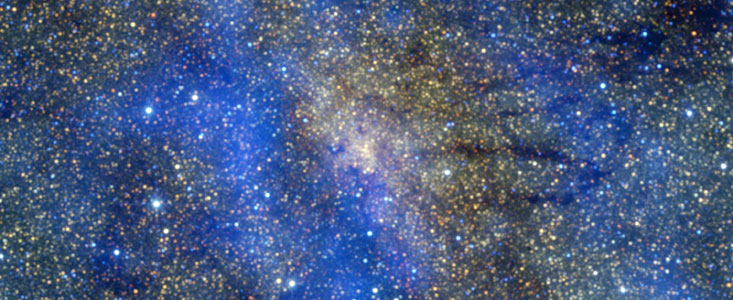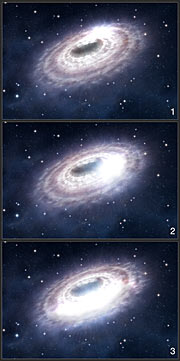Pressemeddelelse
Astronomers detect matter torn apart by black hole
VLT and APEX team up to study flares from the black hole at the Milky Way's core
18. november 2008
Astronomers have used two different telescopes simultaneously to study the violent flares from the supermassive black hole in the centre of the Milky Way. They have detected outbursts from this region, known as Sagittarius A*, which reveal material being stretched out as it orbits in the intense gravity close to the central black hole.
The team of European and US astronomers used ESO's Very Large Telescope (VLT) and the Atacama Pathfinder Experiment (APEX) telescope, both in Chile, to study light from Sagittarius A* at near-infrared wavelengths and the longer submillimetre wavelengths respectively. This is the first time that astronomers have caught a flare with these telescopes simultaneously. The telescopes' location in the southern hemisphere provides the best vantage point for studying the Galactic Centre.
"Observations like this, over a range of wavelengths, are really the only way to understand what's going on close to the black hole," says Andreas Eckart of the University of Cologne, who led the team.
Sagittarius A* is located at the centre of our own Milky Way Galaxy at a distance from Earth of about 26 000 light-years. It is a supermassive black hole with a mass of about four million times that of the Sun. Most, if not all, galaxies are thought to have a supermassive black hole in their centre.
"Sagittarius A* is unique, because it is the nearest of these monster black holes, lying within our own galaxy," explains team member Frederick K. Baganoff of the Massachusetts Institute of Technology (MIT) in Cambridge, USA. "Only for this one object can our current telescopes detect these relatively faint flares from material orbiting just outside the event horizon."
The emission from Sagittarius A* is thought to come from gas thrown off by stars, which then orbits and falls into the black hole.
Making the simultaneous observations required careful planning between teams at the two telescopes. After several nights waiting at the two observatory sites, they struck lucky.
"At the VLT, as soon as we pointed the telescope at Sagittarius A* we saw it was active, and getting brighter by the minute. We immediately picked up the phone and alerted our colleagues at the APEX telescope," says Gunther Witzel, a PhD student from the University of Cologne.
Macarena García-Marín, also from Cologne, was waiting at APEX, where the observatory team had made a special effort to keep the instrument on standby. "As soon as we got the call we were very excited and had to work really fast so as not to lose crucial data from Sagittarius A*. We took over from the regular observations, and were in time to catch the flares," she explains.
Over the next six hours, the team detected violently variable infrared emission, with four major flares from Sagittarius A* . The submillimetre-wavelength results also showed flares, but, crucially, this occurred about one and a half hours after the infrared flares.
The researchers explain that this time delay is probably caused by the rapid expansion, at speeds of about 5 million km/h, of the clouds of gas that are emitting the flares. This expansion causes changes in the character of the emission over time, and hence the time delay between the infrared and submillimetre flares.
Although speeds of 5 million km/h may seem fast, this is only 0.5% of the speed of light. To escape from the very strong gravity so close to the black hole, the gas would have to be travelling at half the speed of light – 100 times faster than detected – and so the researchers believe that the gas cannot be streaming out in a jet. Instead, they suspect that a blob of gas orbiting close to the black hole is being stretched out, like dough in a mixing bowl, and this is causing the expansion.
The simultaneous combination of the VLT and APEX telescopes has proved to be a powerful way to study the flares at multiple wavelengths. The team hope that future observations will let them prove their proposed model, and discover more about this mysterious region at the centre of our Galaxy.
Noter
Sagittarius A* is a compact object located at the centre of our own Milky Way Galaxy, at a distance of about 26 000 light-years from Earth. In recent years, observations of stars orbiting in its strong gravitational grip have convincingly proven that Sagittarius A* must be a supermassive black hole with a mass of about four million times that of the Sun.
The 12 m Atacama Pathfinder Experiment (APEX) telescope is located on the 5000 m high plateau of Chajnantor in the Chilean Atacama desert. APEX is a collaboration between the Max-Planck-Institute for Radio Astronomy (MPIfR), the Onsala Space Observatory (OSO) and ESO. The telescope is based on a prototype antenna constructed for the ALMA project. Operation of APEX at Chajnantor is entrusted to ESO. For this project, the researchers used the LABOCA bolometer camera on APEX.
The Very Large Telescope (VLT) at the 2600 m high Cerro Paranal is ESO's premier site for observations in visible and infrared light. The VLT has four "Unit Telescopes", 8.2 m in diameter, operating with a large collection of instruments. For this project, the researchers used the NACO adaptive optics instrument on the fourth Unit Telescope, "Yepun".
This research is presented in the paper by Eckart et al., "Simultaneous NIR/sub-mm observation of flare emission from Sgr A*", to appear in Astronomy and Astrophysics. It is available online at http://arxiv.org/abs/0811.2753
The members of the international team who did this research are: A. Eckart (University of Cologne, Germany), R. Schödel (Instituto de Astrofísica de Andalucía - CSIC, Spain), M. García-Marín (University of Cologne, Germany), G. Witzel (University of Cologne, Germany), A. Weiss (MPIfR, Germany), F. K. Baganoff (MIT, USA), M. R. Morris (University of California, USA), T. Bertram (University of Cologne, Germany), M. Dovčiak (Astronomical Institute of the Academy of Sciences of Czechia), D. Downes (IRAM, France), W.J. Duschl (Christian-Albrechts-Universität, Germany), V. Karas (Astronomical Institute of the Academy of Sciences of Czechia), S. König (University of Cologne, Germany), T. P. Krichbaum (MPIfR, Germany), M. Krips (Harvard-Smithsonian Center for Astrophysics, USA), D. Kunneriath (University of Cologne, Germany), R.-S. Lu (MPIfR, Germany), S. Markoff (Astronomical Institute 'Anton Pannekoek', Netherlands), J. Mauerhan (University of California, USA), L. Meyer (University of California, USA), J. Moultaka (LATT, France), K. Mužić (University of Cologne, Germany), F. Najarro (Centro de Astro Biologia, Madrid, Spain), J.-U. Pott (University of California, USA), K. F. Schuster (IRAM, France), L. O. Sjouwerman (NRAO, USA), C. Straubmeier (University of Cologne, Germany), C. Thum (IRAM, France), S. Vogel (University of Maryland, USA), H. Wiesemeyer (IRAM, Spain), M. Zamaninasab (University of Cologne, Germany), J. A. Zensus (MPIfR, Germany)
Kontakter
Andreas Eckart
University of Cologne
Cologne, Germany
Tel: +49 221 470 3546
Email: eckart@ph1.uni-koeln.de
Fred Baganoff
Massachusetts Institute of Technology
Cambridge, USA
Tel: +1 617 253 6892
Email: fkb@space.mit.edu
Rainer Schödel
Instituto de Astrofísica de Andalucía
CSIC, Spain
Tel: +34 958 230 529
Email: rainer@iaa.es
Macarena García-Marín
University of Cologne
Cologne, Germany
Tel: +49 221 470 7788
Email: maca@ph1.uni-koeln.de
Douglas Pierce-Price
ESO
Garching, Germany
Tel: +49 89 3200 6759
Email: dpiercep@eso.org
Valentina Rodriguez
ESO
Garching, Germany
Tel: +56 2 463 3123
Email: vrodrigu@eso.org
Om pressemeddelelsen
| Pressemeddelelse nr.: | eso0841 |
| Legacy ID: | PR 41/08 |
| Navn: | Sagittarius A* |
| Type: | Milky Way : Galaxy : Component : Central Black Hole Milky Way : Galaxy : Component : Center/Core |
| Facility: | Atacama Pathfinder Experiment, Very Large Telescope |
| Instruments: | LABOCA, NACO |
| Science data: | 2008A&A...492..337E |



